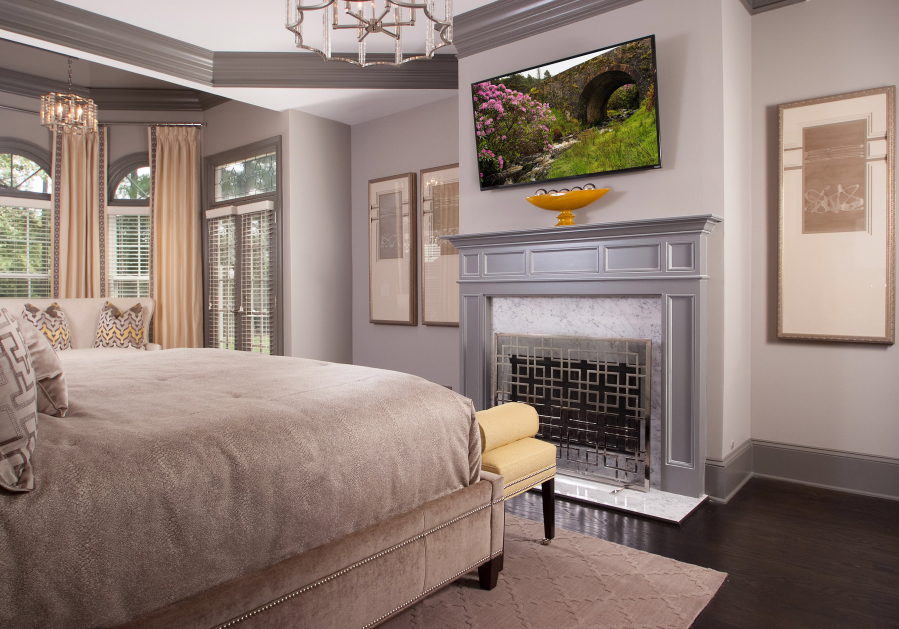Once upon a time — namely, in the 1950s — televisions were big and clunky, yet also status symbols that warranted a prominent spot in America’s living rooms. Then came the 1980s, aka the Era of the Armoire. Electronics were to be hidden, preferably in pieces of huge, clunky furniture we’d all wonder what to do with in five years.
Fast forward, and flat-panel TVs seem to be everywhere — in kitchen backsplashes, behind bathroom medicine-cabinet mirrors, and outdoors. “TVs are as important to my clients as dining tables or king-sized beds,” says Chicago interior designer Jessica Lagrange.
And because they’re larger, thinner and lighter, there’s greater ease and flexibility about where to place them.
Such freedom has led to a conundrum, however: whether to hide them or to display them for what they’ve become — today’s sign of advancing technology, almost akin to integrative artwork. We consulted a host of professionals on what they think are the best way to incorporate TVs into room design. Here’s what we heard:
Hide it
If you prefer a traditional look, Los Angeles designer Sarah Barnard says: “I typically hide it in cabinetry or a wall unit when the style is traditional, since we’re looking back, which means a more classic look. Years ago, decor would not have included unsightly electronics,” she says. But because the newer TVs are much larger, a cabinet often has to be custom made to fit it and hide the gear, which can end up being expensive. The good news is that the slimness of these TVs pares the depth and makes the cabinetry jut out less, says Chicago architect Elissa Morgante of Morgante-Wilson.
Designer Melissa Lewis, of Lewis Giannoulias Interiors, also in Chicago, prefers to find or design the cabinet first; with so many TV sizes, there’s always one that fits.
Atlanta designer Barbara Elliott, of Decorating Den Interiors, prefers to leave a TV in a cabinet in view to avoid the extra step of opening a door or sliding a panel.
Flaunt it
When a more contemporary decor is preferred, Barnard favors leaving the TV in full view since a modern look is more forgiving of technology. Linc Thelen, of Linc Thelen Design in Chicago, concurs. “Sometimes a TV is just a TV, and it’s OK to show it off in the way you leave an appliance in full view in a kitchen,” he says.
Lagrange also likes to celebrate the sleekness of the latest designs. “Now that they look really good they’re often so handsome that they’re anything but obtrusive. Deciding whether to leave them out in the open or hide them depends on the homeowner’s preferences and aesthetics of each space,” she says.
Camouflage it
If you’re not sure, consider a middle ground. Some tactics won’t hide it completely or leave it in full view, but can make it a bit less noticeable: San Francisco designer Claudia Juestel of Adeeni Design Group may surround it with a frame to match a room’s decor; Morgante may paint or wallpaper using a dark palette, so the black TV almost disappears; Thelen may surround it with books in a bookcase as another way to mask it; Lewis favors grass-cloth wallpaper to add texture and coziness.
Lower it
While a TV above a fireplace offers a nice dual focal point, the arrangement requires looking up, not a great ergonomic solution. In fact, most people place wall-installed TVs too high, says Elliott. Greg Porthan, custom audio and video installation manager at ABT Electronics in Glenview, Ill., recommends hanging it 46 inches off the ground in a living space where you sit to watch and between 52 and 55 inches high in a bedroom, since you’re likely sitting up or lying down.
Skip it
Many homeowners are also reassessing whether to include a TV in some rooms, particularly the bedroom, because viewing a screen’s blue light before sleep disrupts the release of melatonin.
Embrace it
Architect Stuart Cohen of Stuart Cohen & Julie Hacker Architects in Evanston, is finding that some clients forgo a fireplace in favor of a TV for better viewing. “It’s more and more the feature that helps center a room,” he says. Some even want a TV in their bathroom.
Size it
Whatever direction you take, choose a TV that’s in proportion to the size of the room. If the TV’s too large, it will throw off the entire room. And a large TV likely will be too close to the couch for safe viewing in a small room, Lewis says. Elliott agrees and suggests a 54- to 60-inch TV that’s 10 feet or so from the couch or chairs in a typical 15-by-20-foot room.



